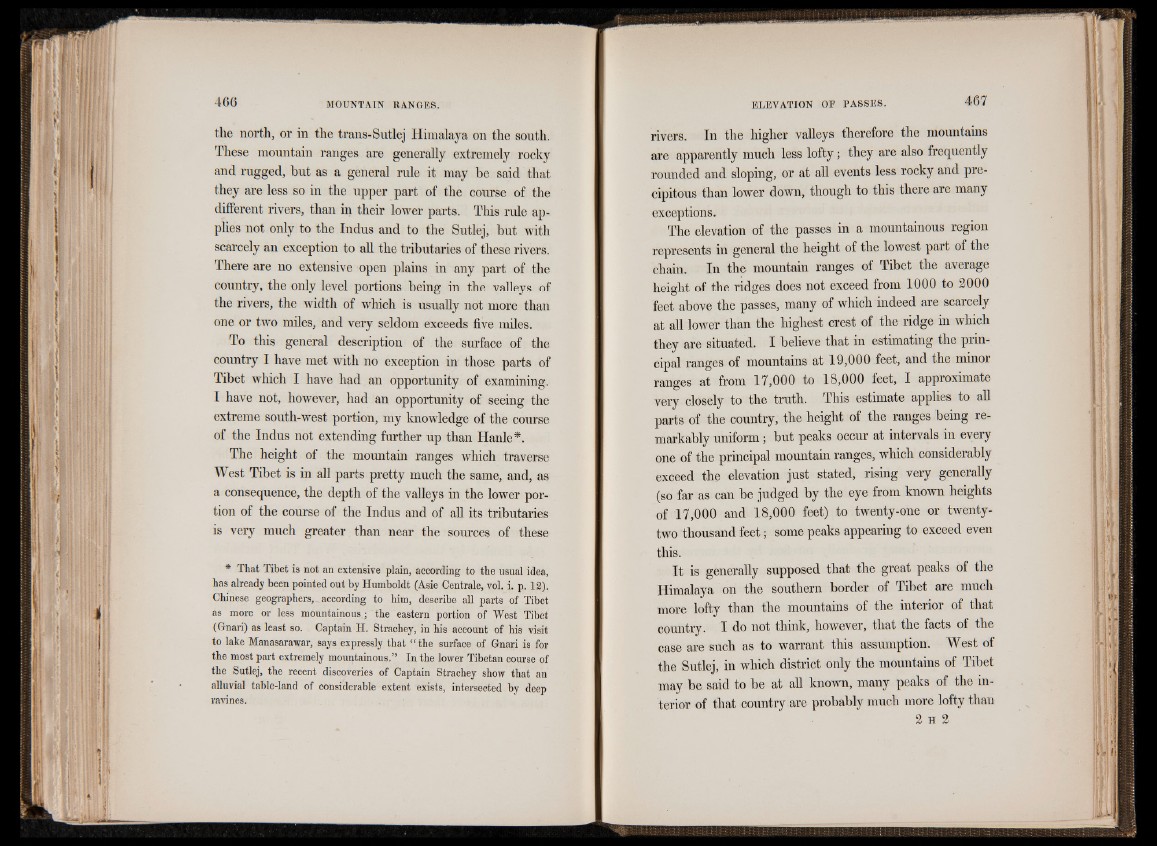
the north, or in the trans-Sutlej Himalaya on the south.
These mountain ranges are generally extremely rocky
and rugged, hut as a general rule it may be said that
they are less so in the upper part of the course of the
different rivers, than in their lower parts. This rule applies
not only to the Indus and to the Sutlej, but with
scarcely an exception to all the tributaries of these rivers.
There are no extensive open plains in any part of the
country, the only level portions being in the valleys of
the rivers, the width of which is usually not more than
one or two miles, and very seldom exceeds five miles.
To this general description of the surface of the
country I have met with no exception in those parts of
Tibet which I have had an opportunity of examining.
I have not, however, had an opportunity of seeing the
extreme south-west portion, my knowledge of the course
of the Indus not extending further up than Hanle*.
The height of the mountain ranges which traverse
West Tibet is in all parts pretty much the same, and, as
a consequence, the depth of the valleys in the lower portion
of the course of the Indus and of all its tributaries
is very much greater than near the sources of these
* That Tibet is not an extensive plain, according to the usual idea,
has already been pointed out by Humboldt (Asie Centrale, vol. i. p. 12).
Chinese geographers,, according to him, describe all parts of Tibet
as more or less mountainous; the eastern portion of West Tibet
(Gnari) as least so. Captain H. Strachey, in his account of his visit
to lake Manasarawar, says expressly that “ the surface of Gnari is for
the most part extremely mountainous.” In the lower Tibetan course of
the Sutlej, the recent discoveries of Captain Strachey show that an
alluvial table-land of considerable extent exists, intersected by deep
ravines.
rivers. In the higher valleys therefore the mountains
are apparently much less lofty; they are also frequently
rounded and sloping, or at all events less rocky and precipitous
than lower down, though to this there are many
exceptions.
The elevation of the passes in a mountainous region
represents in general the height of the lowest part of the
chain. In the mountain ranges of Tibet the average
height of the ridges does not exceed from 1000 to 2000
feet above the passes, many of which indeed are scarcely
at all lower than the highest crest of the ridge in which
they are situated. I believe that in estimating the principal
ranges of mountains at 19,000 feet, and the minor
ranges at from 17,000 to 18,000 feet, I approximate
very closely to the truth. This estimate applies to all
parts of the country, the height of the ranges being remarkably
uniform; but peaks occur at intervals in every
one of the principal mountain ranges, which considerably
exceed the elevation just stated, rising very generally
(so far as can be judged by the eye from known heights
of 17,000 and 18,000 feet) to twenty-one or twenty-
two thousand feet; some peaks appearing to exceed even
this.
It is generally supposed that the great peaks of the
Himalaya on the southern border of Tibet are much
more lofty than the mountains of the interior of that
country. I do not think, however, that the facts of the
case are such as to warrant this assumption. West of
the Sutlej, in which district only the mountains of Tibet
may be said to be at all known, many peaks of the interior
of that country are probably much more lofty than
2 h 2